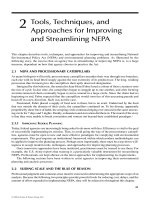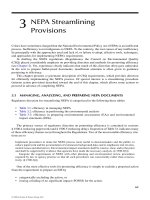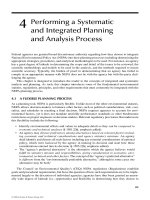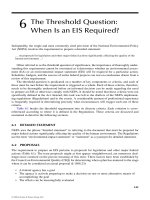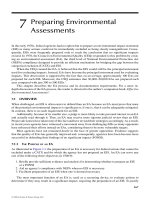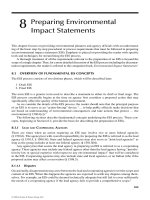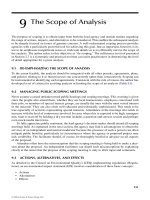Environmental Sampling and Analysis for Metals - Chapter 12 doc
Bạn đang xem bản rút gọn của tài liệu. Xem và tải ngay bản đầy đủ của tài liệu tại đây (272.45 KB, 18 trang )
Inductively Coupled Plasma
Atomic Emission Spectroscopy
12.1 ATOMIC EMISSION SPECTROSCOPY (AES)
In AES, the sample is subjected to temperatures high enough to cause not only dissociation into
atoms, but also significant amounts of collisional excitation (and ionization) of the sample atoms.
Once the atoms and ions are in their excitation states, they can decay to lower states through thermal
or radioactive (emission) energy transition. (See discussion of emission in Section 5.4.) In AES, the
intensity of the light emitted is measured at specific wavelengths and used to determine the concen-
trations of the elements of interest.
Thermal excitation sources can populate a large number of different energy levels for several dif-
ferent elements at the same time. Consequently, all excited atoms and ions can emit characteristic ra-
diation at nearly the same time. In general, three types of thermal sources are used in analytical
atomic spectrometry to dissociate sample molecules into free atoms: flames, furnaces, and electrical
discharges. The first two types are hot enough to dissociate most types of molecules into free atoms.
Electrical discharges, the third type, are also called
plasmas.
12.1.1 PLASMAS
Plasma is a state of matter usually consisting of highly ionized gas that contains an appreciable frac-
tion of equal numbers of ions and electrons in addition to neutral atoms and molecules. Plasmas con-
duct electricity and are affected by magnetic fields. The plasma source has a high degree of stability
to overcome interference effects. Plasma is capable of exciting several elements that are not excited
by flames and has increased sensitivity to flame AES. The low detection limits, freedom from inter-
ferences, and long-line working ranges prove that it is a superior technique for AES. For more detail
about plasmas, see Appendix J.
The
electrical plasmas used in AES work are highly energetic ionized gases and are usually pro-
duced in inert gases. The plasma source for analytical AES is argon-supported inductively coupled
plasma (ICP).
12.1.2 SHORT HISTORY OF AES
In the 1860s, Kirchhoff and Bunsen developed methods based on emission spectroscopy that led to
the discovery of four elements: cesium (Cs), rubidium (Rb), titanium (Ti), and indium (In). At this
time, the emitted lines were used in qualitative analytical work.
In the mid-twentieth century, quantitative emission spectroscopy was the tool used to determine
trace concentrations for a wide range of elements, but sample preparation techniques were very dif-
ficult and time consuming.
The atomic spectra emitted from flames had the advantage of being simpler and easier. This tech-
nique, called
flame emission spectrometry (also known as flame photometry) is used to determine
12
161
© 2002 by CRC Press LLC
162 Environmental Sampling and Analysis for Metals
alkali metals and other easily excitable elements. Swedish agronomist Lundegardth is credited with
initiating the modern era of flame photometry in the late 1920s. This technique is commonly used in
clinical laboratories for determining sodium and potassium levels in biological materials.
In the 1960s and 1970s,
flame atomic absorption (FAA) was the preferred technique for the deter-
mination of trace metals. FAA offers high precision and moderate detection limits.
Electrothermal at-
omization
,orgraphite furnace atomic absorption spectrophotometry (GrAAS), on the other hand, of-
fers high sensitivity and lower detection limits, but poorer precision and a higher level of matrix inter-
ferences. However, most of these interferences have been reduced or eliminated (see Section 9.4). Both
FAA and GrAAS techniques are widely used today and provide excellent means of trace element analy-
sis. However, most atomic absorption instruments are limited in that they measure only one element at
a time. Instrument setup or operating conditions may require changing hollow cathode lamps or using
different furnace parameters for each different element to be determined. Because of the limited cali-
bration range in AAS techniques, the need for sample dilution is much greater than in AES techniques.
The first report (Greenfield et al.) about the use of an
atmospheric pressure inductively coupled
plasma
(ICP) for element analysis via AES was published in England in 1964.
At the same time, Velmer Fassel and colleagues at Iowa State University refined the technique
and made it practical for laboratory use. By 1973, ICP was promoted as the most popular technique
in analytical emission spectrometry because of its low detection limits, long linear working ranges,
and freedom from interference.
12.2 GENERAL CHARACTERISTICS OF ICP-AES
Emission spectroscopy using ICP is a rapid, sensitive, and convenient method for the determination of
elements, including metals, in solution. All matrices, including groundwater, aqueous samples, extracts,
wastes, soils, sludges, sediments, and other solid wastes require digestion prior to analysis. (Sample
preparation procedures are discussed in Chapter 15.) Routine determination of 70 elements can be made
by ICP-AES at concentration levels below 1 mg/l. Table 12.1 lists recommended wavelengths and cor-
responding estimated detection limits. The detection limits are provided as a guide for instrument lim-
its. In reality, method detection limits are sample dependent and vary according to the sample matrix.
Detection limits, sensitivity, and optimum ranges of metals vary by matrix and instrument model.
12.2.1 GENERAL DISCUSSION
The ICP method measures element-emitted light by optical spectrometry. Samples are nebulized and
the resulting aerosol is transported to the plasma torch. Element-specific, atomic-line emission spec-
tra are produced by radio-frequency inductively coupled plasma. The spectra are dispersed by a grat-
ing spectrometer, and the line intensities are monitored by photomultiplier tubes. The background
must be measured adjacent to analyte lines on samples during analysis.
An ICP source consists of a
flowing stream of argon gas ionized by an applied radio frequency
field
that typically oscillates at 27.1 MHz. This field is inductively coupled to the ionized gas by a
water-cooled coil surrounding a
quartz torch that supports and confines the plasma (see Section
12.2.3). A
sample aerosol is generated in an appropriate nebulizer and spray chamber and enters the
plasma through an
injector tube located in the torch (Section 12.3.1). The sample aerosol is injected
directly into the ICP, subjecting the constituent atoms to temperatures of about 6000 to 8000 K.
Because this procedure results in almost complete dissociation of molecules, significant reduction in
chemical interferences is achieved. The high temperature of the plasma excites element-specific
atomic-line-emission spectra. The spectra are dispersed by a grating spectrometer, and the intensi-
ties of the lines are monitored by
photomultiplier tubes.
© 2002 by CRC Press LLC
Inductively Coupled Plasma Atomic Emission Spectroscopy 163
The ICP provides an optically “thin” source that is not subject to self-absorption except in very high
concentrations. Thus,
linear dynamic ranges of four to six orders of magnitude are observed for many
elements. The efficient excitation provided by the ICP results in low concentrations. Coupled with the
extended dynamic range, such efficiency permits effective multielement determination of metals.
12.2.2 PERFORMANCE CHARACTERISTICS
The ICP-AES technique is applicable to the determination of a large number of elements at micro-
gram-per-liter (ppb) levels. For precise quantitation, the element’s concentration should be 50 to 100
times higher than the detection limit. ICP-AES analysis is not recommended for low-level concen-
tration elements or elements that are naturally entrained into the plasma from sources other than the
TABLE 12.1
Recommended Wavelengths and Estimated Instrumental
Detection Limits for ICP
Element Wavelength (nm)
a
Estimated DL
b
(µg/l)
Aluminum 308.215 45
Antimony 206.833 32
Arsenic 193.696 53
Barium 455.403 2
Beryllium 313.042 0.3
Boron 249.773 5
Cadmium 226.502 4
Calcium 317.933 10
Chromium 267.716 7
Cobalt 228.616 7
Copper 324.754 6
Iron 259.940 7
Lead 220.353 42
Magnesium 279.079 30
Manganese 257.610 2
Molybdenum 202.030 8
Nickel 231.604 15
Potassium 766.491
c
Selenium 196.026 75
Silicon 288.158 58
Silver 328.068 7
Sodium 588.995 29
Thallium 190.864 40
Vanadium 292.402 8
Zinc 213.856 2
a
The wavelengths listed are recommended because of their sensitivity and overall accept-
ance. Other wavelengths may be substituted if they can provide the needed sensitivity and
are treated with the same corrective techniques for spectral interference. In time, other el-
ements may be added as more information becomes available and as required.
b
The estimated detection limits are provided as a guide for an instrument limit. In reality,
method detection limits are sample dependent.
c
Highly dependent on operating conditions and plasma position.
© 2002 by CRC Press LLC
164 Environmental Sampling and Analysis for Metals
analyzed sample, such as traces of argon and CO
2
from argon gas, H
2
and O
2
when water is the sol-
vent, C from organic solvent, and H
2
, O
2
, and N
2
from air. ICP-AES should also not be used to deter-
mine elements whose atoms have very high excitation energy requirements, such as fluorine, chlo-
rine, the noble gases, and synthetic elements. Table 12.2 lists elements by suggested and alternate
wavelengths, estimated detection limits, calibration concentrations, and typical upper limits for lin-
ear calibration.
One advantage of ICP-AES is its long linear dynamic range. (Linear dynamic range is discussed
in Section 7.5.1.) This range makes possible instrument calibration to a one- or two-point curve.
Another advantage is that less sample dilution is necessary. With this technique, operators can deter-
mine a large number of elements over a wide range of concentrations, and many elements can be de-
termined in the same analytical run. The precision and accuracy of ICP-AES results are sufficient for
TABLE 12.2
Suggested Wavelengths, Estimated Detection Levels, Alternate Wavelengths, Calibration
Concentrations, and Upper Limits
Suggested Estimated Alternate Calibration Upper Limit
Wavelength Detection Wavelength Concentration
a
Concentration
Element (nm) (µg/l) (nm) (mg/l) (mg/l)
Al 308.22 40 237.32 10.0 100
Sb 206.83 30 217.58 10.0 100
As 193.70 50 189.04
b
10.0 100
Ba 455.40 2 493.41 1.0 50
Be 313.04 0.3 234.86 1.0 10
B 249.74 5 249.68 1.0 50
Cd 226.50 4 214.44 2.0 50
Ca 317.93 10 315.89 10.0 100
Cr 267.72 7 206.15 5.0 50
Co 228.62 7 230.79 2.0 50
Cu 324.75 6 219.96 1.0 50
Fe 259.94 7 238.20 10.0 100
Pb 220.35 40 217.00 10.0 100
Li 670.78 4
c
— 5.0 100
Mg 279.08 30 279.55 10.0 100
Mn 257.61 2 294.92 2.0 50
Mo 202.03 8 203.84 10.0 100
Ni 231.60 15 221.65 2.0 50
K 766.49 100
c
769.90 10.0 100
Se 196.03 75 203.99 5.0 100
SiO
2
212.41 20 251.61 21.4 100
Ag 328.07 7 338.29 2.0 50
Na 589.00 30
c
589.59 10.0 100
Sr 407.77 0.5 421.55 1.0 50
Tl 190.86
b
40 377.57 10.0 100
V 292.40 8 — 1.0 50
Zn 213.86 2 206.20 5.0 100
a
Other wavelengths may be substituted if they provide the needed sensitivity and are corrected for spectral interference.
b
Available with vacuum or inert gas purged optical path.
c
Sensitive to operating conditions.
© 2002 by CRC Press LLC
Inductively Coupled Plasma Atomic Emission Spectroscopy 165
most analytical work. Compared to other analytical atomic spectrometry techniques, ICP-AES is
subject to the lowest number of interferences. Interferences are discussed in Section 12.4.
12.2.3 ICP DISCHARGE
Argon gas is directed through a torch consisting of three concentric tubes made of quartz or another
suitable material. A copper coil, called the load coil, surrounds the top end of the torch and is con-
nected to a radio-frequency (RF) generator. When RF power (typically 700–1500 W) is applied to
the load coil, an alternating current moves back and forth (oscillates) within the coil at a rate corre-
sponding to the frequency of the generator (27–40 MHz). Oscillation of the current in the coil
causes RF electric and magnetic fields to be set up in the area at the top of the torch. With argon gas
being swirled through the torch, a spark is applied to the gas causing electrons to be stripped from
argon atoms. These electrons are then caught up in the magnetic field and accelerated by it. Adding
energy to the electrons by the use of a coil in this manner is known as inductive coupling. These
high-energy electrons collide with other argon atoms and produce more electrons. This collisional
ionization of the argon gas continues and breaks down the gas into a plasma consisting of argon
atoms, electrons, and ions, forming the inductively coupled plasma discharge. This ICP discharge
is then sustained by the torch and load coil, as RF energy is continually transferred to it during the
inductive coupling process.
FIGURE 12.1 ICP zones: IR, induction region; PHZ, preheat-
ing zone; IRZ, initial radiation zone; and NAZ, normal analyti-
cal zone.
FIGURE 12.2 Temperature regions of typical ICP discharge.
© 2002 by CRC Press LLC
166 Environmental Sampling and Analysis for Metals
The ICP discharge is very intense, brilliant white, and teardrop-shaped. Figures 12.1 and 12.2
illustrate the ICP zones and plasma temperature regions, respectively.
12.2.3.1 Plasma Functions
12.2.3.1.1 Desolvation
The first function of the high-temperature ICP is to remove the solvent from the sample droplet or
desolvate, leaving the sample as microscopic salt particles.
12.2.3.1.2 Vaporization and Atomization
The salt particles decompose into gas molecules and then dissociate into atoms. These processes
occur in the
preliminary zone (PHZ) of the ICP (see Figure 12.1).
12.2.3.1.3 Excitation and Ionization
As discussed previously, an electron of any atom or ion can be promoted to a higher energy level by
an excitation process during which it emits characteristic radiation. This process occurs in the
initial
radiation zone
(IRZ) and in the normal analytical zone (NAZ) (see Figure 12.2).
12.2.3.1.4 Emission Measurement
The light emitted by the excited atoms and ions is measured in the NAZ region of the plasma. The
emitted light of diverse wavelengths is measured with a polychromator and detected by a photomul-
tiplier tube. The wavelengths are separated by a monochromator.
12.3 ICP-AES INSTRUMENTATION
In ICP-AES, the sample is usually transported into the instrument in the form steam from a liquid
sample. The liquid is converted into an aerosol and transported to the plasma where it is vaporized,
atomized, and excited or ionized. The emitted radiation is collected and measured. The major com-
ponents and layout of a typical ICP-AES instrument are illustrated in Figure 12.3.
Radio
Frequency
Generator
Pump
Nebulizer
Computer
To Waste
Sample
Argon
Transfer
Optics
Spectrometer
PMT
ICP
Torch
Spray
Chamber
Microprocessor
and
Electronics
FIGURE 12.3 Major components and layout of a typical ICP-AES instrument.
© 2002 by CRC Press LLC
Inductively Coupled Plasma Atomic Emission Spectroscopy 167
12.3.1 SAMPLE INTRODUCTION
12.3.1.1 Nebulizers
Nebulizers convert a liquid into an aerosol that can be transported to the plasma, where it is desolved,
vaporized, atomized, ionized, and excited. The type of nebulizer used depends on the samples to be
analyzed as well as the equipment.
12.3.1.2 Pumps
The sample solution is pumped to the nebulizer; with the help of a series of rollers, the solution is
pushed through the tubing. The tubing is made of materials that are not affected by acidic solutions,
organic solvents, and hydrogen fluoride. The instrument’s operating manual includes instructions for
the use of proper tubing. The peristalting pump tubing is the only part of an ICP system that typically
requires frequent replacement. The tubing should be checked daily for wear, which is indicated by
permanent depressions that can be detected by running one’s fingers over the tubing.
12.3.1.3 Spray Chambers
Between the nebulizer and torch is the spray chamber, as seen in Figure 12.3. The chamber removes
large droplets from the aerosol before it enters the plasma and smoothes out pulses. The diameter
of the slow droplets entering the plasma should be about 10
µm or smaller. These droplets consti-
tute about 1% to 5% of the sample, and the remaining 95% to 99% of the sample is drained into a
waste container.
12.3.1.4 Drains
The drain carries the excess sample from the spray chamber to the waste container and provides the
backpressure necessary to force the sample aerosol carrying the gas flow through the torch injector
tube and into the plasma discharge. If the drain system does not drain evenly or it allows bubbles to
pass through, the injection of the sample to the plasma will be disrupted and noisy emission signals
can result.
12.3.2 EMISSION PRODUCTION
12.3.2.1 Torches
The torches contain three concentric tubes for argon gas flow and aerosol injection (see Sections
12.2.1 and 12.3.1). The spacing between the two outer tubes is very narrow so that the gas flows be-
tween them at high velocity and in a spiral movement, thereby keeping the quartz walls of the tubes
cool. For this reason, the argon gas flow is also called the
coolant flow or plasma flow (because the
gas flow makes the plasma). In argon ICPs, it is known as plasma gas flow, and the flow rate is 7 to
15 l/min.
The gas flow carrying the sample aerosol is injected into the plasma through a central tube called
the
injector. Because this flow carries the sample to the plasma, it is called the sample flow. When
used as the nebulization gas, it is called the
nebulizer flow. The flow rate is usually 1 l/min, and is
known as the
auxiliary flow. The three flows are illustrated in Figure 12.4.
The most popular torches can be fitted with various injector tubes, including corrosion-resistant
ceramic injectors, injectors for analyzing organic solvents, and injectors for introducing samples con-
taining highly dissolved solids.
© 2002 by CRC Press LLC
168 Environmental Sampling and Analysis for Metals
12.3.2.2 Radio-Frequency (RF) Generators
The RF generator provides the power (generally 600–1800 W) for the plasma torch. Heat is trans-
ferred to the plasma gas through a
load coil surrounding the top of the torch. The load coil is usually
made of copper tubing, and during operation it is cooled by water or gas. Most ICP-AES generators
operate at a frequency of 27 to 56 MHz.
12.3.3 COLLECTION AND DETECTION OF EMISSIONS
12.3.3.1 Transfer Optics
The emission radiation from the normal analytical zone (NAZ) of the plasma is collected by a fo-
cusing optic
, such as a convex lens or a concave mirror, which transfers it onto the entrance slit of
the wavelength-dispersing device.
12.3.3.2 Wavelength-Dispersive Device
The collected emission radiation is then differentiated by elements, accomplished with a diffraction-
grating-based dispersive device. (Diffraction grating is discussed in Section 6.2.1.) This device is
simply a mirror with closely spaced lines etched into its surface, with a density of 600 to 4200 lines
per millimeter. When light strikes such a grating, the light is diffracted at an angle, which is depend-
ent on the wavelength of light and the line density of the grating. The longer the wavelength and the
higher the line density, the higher the diffraction angle will be. The grating is incorporated in a
spec-
trometer
. The spectrometer generates the light beam, disperses it according to wavelengths selected
by the grating, and focuses them to the appropriate
exit slits. At this point, the wavelengths are passed
to the detector. A
polychromator is a device comprised of several exit slits and detectors in the same
spectrometer. When only one exit slit and detector are used, the device is called a
monochromator.
Both devices can be used for multielement analysis in ICP-AES instruments. Most of the analytical
emission lines in ICP-AES are in the 190 to 450 nm region. With these wavelengths, electromagnetic
radiation is absorbed by oxygen molecules; therefore, air should removed from the spectrometer by
purging it with nitrogen gas or by using a vacuum system.
Plasma Flow
Auxiliary Flow
Nebulizer
Flow
Viewing Slot
Load Coil
Injector Tube
FIGURE 12.4 Schematic of a torch used for ICP-AES.
© 2002 by CRC Press LLC
Inductively Coupled Plasma Atomic Emission Spectroscopy 169
12.3.3.4 Detectors
The detector measures the intensity of the emission line. The photomultiplier tube (see Section 7.3.5)
— the most widely used detector in ICP-AES — consists of a vacuum tube containing a
photocath-
ode
that ejects electrons when struck by light. These electrons travel to a dynode that produces one
to five secondary electrons for every electron striking its wall. The secondary electrons strike another
diode, producing new electrons, and so on. A typical photomultiplier tube contains 9 to 16 dynode
stages. The anode in the tube collects the electrons from the last dynode. As many as 10
6
secondary
electrons are produced from a single photon striking the photocathode in the tube. The electrical cur-
rent at the anode is measured as the intensity of the radiation reaches the phototube. Figure 12.5 il-
lustrates how the signal produced by a photon in a photomultiplier tube is measured.
12.3.4 SIGNAL PROCESSING AND INSTRUMENT CONTROL
12.3.4.1 Signal Processing
The electrical current measured at the anode of the photomultiplier tube is converted to information
that can be passed on to a computer or immediately accessed by the analyst.
12.3.4.2 Computers and Processors
The incorporated computer is an important part of an ICP-AES instrument. Every commercial ICP-
AES instrument available today uses some type of computer to control the spectrometer and to col-
lect, manipulate, and report analytical data. The amount of control over other functions of the in-
strument varies widely from model to model.
Photocathode
Secondary
Electrons
Measurement
Device
Anode
Dynodes
hν
e
-
FIGURE 12.5 Photocathode, dynode, and anode layout of photomultiplier tube.
© 2002 by CRC Press LLC
170 Environmental Sampling and Analysis for Metals
12.3.5 ACCESSORIES FOR ICP-AES INSTRUMENTS
12.3.5.1 Autosamplers
Typical autosamplers have a capacity of 40 to 60 samples, but some models can hold 100 samples.
Ideally, the analyst should be able to load the autosampler with standards and samples, start the
analysis, walk away, and return to find the analysis completed.
12.3.5.2 Sample Introduction Accessories
Sample introduction accessories are widely used with ICP-AES instruments. These accessories are
available directly from the instrument manufacturer or can be constructed in the laboratory.
In the
hydride generation technique, the sample in dilute acid is mixed with a reducing agent,
usually a solution of sodium borohydride in diluted sodium hydroxide. The reaction of the sodium
borohydride with the acid produces atomic hydrogen. Atomic hydrogen then reacts with Hg, Sb, As,
Bi, Ge, Pb, Se, Te, and Sn in the solution to form volatile hydrides of these elements. These gaseous
compounds are separated from the rest of the reduction mixture and transported to the plasma. The
detection limits may increase by a factor of up to 1000 by using this technique.
Another technique for ICP-AES sample introduction is a
graphite furnace or other electrother-
mal device to vaporize a small portion of a liquid or solid sample. In this technique, the sample in-
troduction system is replaced by a graphite furnace (see Section 9.2.4). The vapor of the sample goes
to the center of the ICP discharge in the ICP torch.
12.3.6 INSTRUMENT CARE AND MAINTENANCE
12.3.6.1 Sample Introduction and ICP Torch
Keeping the torch and sample introduction system clean and free from obstructions is important in
ensuring a smooth, uncontaminated flow of sample to the plasma. Run a blank solution for several
minutes after an analysis is completed or before the instrument is shut down for the day. After run-
ning a sample with a complex matrix, the sample introduction system requires a thorough cleaning.
Check for depressions or flat spots on the tubing. Manually stretch new tubes before placing them on
the peristaltic pump head. Make sure that the tubing is appropriate for the sample type.
12.3.6.2 Nebulizer
Make sure that the nebulizer is not clogged or leaking. When checking the aerosol for a uniform spray
pattern, be sure to use deionized water and wear eye protection.
12.3.6.3 Drain System
The drain system should be filled with liquid to the level that will provide the proper backpressure
for the nebulizer gas flow. Waste from the spray chamber should flow smoothly.
12.3.6.4 Torch
Check for leaks caused by damaged quartz tubes. Deposits on the torch should be removed. Check
and clean the clogged injector after analyzing samples with high levels of particulates or dissolved
solids. When analyzing organic-based samples, check and remove carbon deposits from the torch
and injector.
© 2002 by CRC Press LLC
Inductively Coupled Plasma Atomic Emission Spectroscopy 171
12.3.6.5 RF Generator
The RF load coil should be checked for corrosion or leakage. The high-voltage wires and other parts
of the ignition system must be checked and replaced if corroded. The power amplifier tubes must be
checked, but replacement should be performed only by professionals. Always be sure that the labo-
ratory exhaust venting system for the ICP torch box is functioning properly before igniting the
plasma. Harmful ozone, toxic combustion products, and metal fumes may accumulate in the labora-
tory if not vented properly.
12.3.6.6 Spectrometer
Windows should be regularly inspected and carefully cleaned or replaced as necessary. Periodically
check wavelength calibration as described in Section 6.7.
12.3.6.7 Computer
Conduct regular routine computer maintenance, such as cleaning disk drives and air filters. If data
files are stored on the hard disk, “clean up” the data file directories by erasing files or transferring
them to disks.
12.3.7 VERIFICATION OF INSTRUMENT PERFORMANCE
Several tests are available to verify that the instrument is working properly. Some of these tests
should run on a daily basis, and some should be used as diagnostic tests to verify problems indicated
by erratic results. Before running tests, wait for the instrument to warm up properly. The warm-up
usually takes 30 to 60 min.
12.3.7.1 Bullet Test
The visual bullet test should be performed on a daily basis. A solution of yttrium or sodium in a con-
centration of 1000 mg/l or more is introduced into the system. The emission should produce a so-
called “bullet” in the center of the ICP discharge. The mere presence of the bullet indicates that the
sample aerosol is reaching the plasma, while the vertical position of the bullet in the discharge is an
indicator of the gas flow and RF power settings.
12.3.7.2 Signal Intensity
The number of emission counts (called signal intensity) for an element with known concentration is
frequently measured, because the emission count for a given concentration may vary from day to day.
12.3.7.3 Background Equivalent Concentration (BEC)
The BEC is an indicator of relative sensitivity for an emission line. A BEC of a higher-than-normal
value often indicates problems with the efficiency of the sample introduction system, although it can
be due to a number of causes.
12.3.7.4 Precision
The precision of an argon emission line is sometimes used as a diagnostic test for the RF generator.
Precision is discussed in Section 13.9.
© 2002 by CRC Press LLC
172 Environmental Sampling and Analysis for Metals
12.3.7.5 Detection Limits
Detection limits may also be used for diagnostic purposes. Detection limits and measurements are de-
scribed in Section 13.8. The measured detection limits alone do not serve as an indicator of an instru-
ment’s performance, unless the measurement is combined with a series of other, more specific tests.
12.3.7.6 Wavelengths
Because UV/Vis spectrometers are subject to drift, ensure that the spectrometer is calibrated properly
in terms of wavelength prior to ICP analysis. In some instruments, calibration is performed by the in-
strument software at the beginning of the analysis, but some instruments require manual checking.
12.4 INTERFERENCES IN ICP-AES
Most interferences are of spectral origin. Other types of interference are often the result of high con-
centrations of certain elements or compounds in the sample matrix and can be easily compensated
for in most cases.
12.4.1 SPECTRAL INTERFERENCES AND CORRECTIONS
Light emission from spectral sources other than the element of interest may increase the apparent sig-
nal intensity. Spectral interferences are caused by (1) overlap of a spectral line from another element;
(2) unresolved overlap of molecular spectra; (3) background contribution; and (4) stray light from the
line emission of high-concentration elements.
12.4.1.2 Spectral or Background Interferences
The following interferences are well known to users of the ICP-AES technique:
• Simple and sloping background shift
• Direct spectral overlap
• Complex background shift
12.4.1.2.1 Correction of Spectral Interferences
• Alternate analytical wavelengths: Avoid line overlaps by selecting alternate analytical
wavelengths.
• Interelement correction: Measure the emission intensity of the interfering element at an-
other wavelength and calculate a correction factor (Section 12.6.8). This factor should
apply to determine the correct result. This technique is often useful in correcting the sim-
ple, sloping, and complex background shifts. Analyte concentration equivalents arising
from interference at the 100-mg/l level are presented in Table 12.3. The interference is ex-
pressed as analyte concentration arising from 100 mg/l of interference element. For ex-
ample, assume that As is to be determined (at 193.696 nm) in a sample containing ap-
proximately 10 mg/l of Al. According to Table 12.3, 100 mg/l of Al would yield a false sig-
nal for As equivalent to approximately 1.3 mg/l. Therefore, the presence of 10 mg/l of Al
would result in a false signal for As equivalent to approximately 0.13 mg/l. The interfer-
ence effects must be evaluated for each individual instrument.
© 2002 by CRC Press LLC
Inductively Coupled Plasma Atomic Emission Spectroscopy 173
12.4.2 NONSPECTRAL INTERFERENCE
12.4.2.1 Physical Interference
Physical interference is associated with nebulization and transportation processes. Changes in the
physical properties of samples, such as viscosity and surface tension, in highly dissolved solids and
high-acid concentrations can cause significant errors. Physical interferences may be compensated
with sample dilution or by the standard addition technique (see Section 7.7.1). Samples consisting of
highly dissolved solids may cause salt buildup at the tip of nebulizer. Using prehumidified argon for
each sample nebulization is helpful.
12.4.2.2 Chemical Interferences
Chemical interference is caused by molecular compound formation, ionization effects, and sample va-
porization. Chemical interference is highly dependent on the sample matrix and the element of interest.
These conditions are easily minimized by careful selection of operating conditions. Similar to physical
interference, chemical interference may be compensated by using matrix-matched standards or by
using the standard additions method.
TABLE 12.3
Analyte Concentration Equivalents Arising from Interference at the 100-mg/l Level
Interference
a,b
Metal Wavelength (nm) Al Ca Cr Cu Fe Mg Mn Ni Tl V
Al 308.215 ————— —0.21 ——1.4
Sb 206.833 0.47 — 2.9 — 0.08 —— —0.25 0.45
As 193.696 1.3 — 0.44 —— — — — —1.1
Ba 455.403 ————— —— — — —
Be 313.042 ————— —— —0.04 0.05
B 249.773 0.04 ———0.32 —— — ——
Cd 226.502 ————0.03 ——0.02 ——
Ca 317.933 ——0.08 — 0.01 0.01 0.04 — 0.03 0.03
Cr 267.716 ————0.003 — 0.04 ——0.04
Co 228.616 ——0.03 — 0.005 ——0.03 0.15 —
Cu 324.754 ————0.003 ——0.05 — 0.02
Fe 259.940 ————— —0.12 ———
Pb 220.253 0.17 ———— —— — — —
Mg 279.079 — 0.02 0.11 — 0.13 — 0.25 — 0.07 0.12
Mn 257.610 0.005 — 0.01 — 0.002 0.002 ————
Mo 202.030 0.05 ———0.03 —— — ——
Ni 231.604 ————— —— — — —
Se 196.026 0.23 ———0.09 —— — ——
Si 288.158 ——0.07 —— — — — —0.01
Na 588.995 ————— —— —0.08 —
Tl 190.864 0.30 ———— —— — — —
V 292.402 ——0.05 — 0.005 —— —0.02 —
Zn 213.856 ———0.14 ———0.29 ——
a
Dashes indicate that no interference was observed even when interferences were introduced at the following levels:
Al, 1000 mg/l; Mg, 1000 mg/l; Ca, 1000 mg/l; Mn, 200 mg/l; Cr, 200 mg/l; Tl, 200 mg/l; Cu, 200 mg/l; V, 200 mg/l;
and Fe, 1000 mg/l.
b
The figures recorded as analyte concentrations are not observed concentrations. To obtain those figures, add the
listed concentrations to the interference figure.
© 2002 by CRC Press LLC
174 Environmental Sampling and Analysis for Metals
12.5 REAGENTS AND STANDARDS
12.5.1 C
HEMICALS, STANDARDS, AND REAGENTS
• Chemicals and reagents should be ultra-high-purity grades, except as noted.
• Dry all salts at 105°C for 1 h and store in a desiccator before weighing.
• Use deionized water prepared by passing it through at least two stages of a deionization
process for preparing standards, reagents, and dilutions. Criteria and checks of laboratory
pure-water quality are covered in Section 13.4.
12.5.2 ACIDS
• Hydrochloric acid, HCl concentrate, and 1+1
• Nitric acid, HNO
3
concentrate, and 1+1
Add 500 ml of HNO
3
concentrate to 400 ml of water and dilute to 1 liter.
12.5.3 STANDARD STOCK SOLUTIONS
Standard stock solutions can be purchased or prepared from chemicals or metals. See Appendix H
for recipes of these stock solutions. Store metal stock solutions at room temperature with a record of
arrival, date opened, and expiration date (see Section 13.6.1).
12.5.4 MIXED CALIBRATION STANDARD SOLUTIONS
• Prepare mixed calibration standard solutions by combining appropriate volumes of the
stock solutions in 100-ml volumetric flasks.
• Add 2 ml 1:1 HNO
3
and 10 ml 1:1 HCl and dilute to 100 ml with distilled water. Mix well.
Store the mixed standards in FEPs (fluorocarbon or unused polyethylene bottles).
Concentrations of standards can change with aging! Verify concentrations by using quality con-
trol sampling and monitor weekly for stability. Some typical combinations of mixed standards fol-
low, although alternative combinations are acceptable.
Mixed standard solution I: Be, Cd, Mn, Pb, Se, and Zn
Mixed standard solution II: Ba, Co, Cu, Fe, and V
Mixed standard solution III: As, Mo, and Si
Mixed standard solution IV: Al, Ca, Cr, K, Na, and Ni
Mixed standard solution V: Ag, B, Mg, Sb, and Tl
Note: If the addition of Ag to the recommended acid combination results in an initial precipitation,
add 15 ml of distilled water and warm the flask until the solution clears. Cool and dilute to 100 ml
with distilled water. The Ag concentration should be limited to 2 mg/l, which is stable for 30 days.
Higher concentrations of Ag require additional HCl.
12.5.5 BLANKS
12.5.5.1 Calibration Blank
Measure 2 ml 1+1 HNO
3
and 10 ml 1+1 HCl and dilute to 100 ml with laboratory pure water. Prepare
a sufficient quantity to be used to flush the system between standards and samples.
© 2002 by CRC Press LLC
Inductively Coupled Plasma Atomic Emission Spectroscopy 175
12.5.5.2 Method Blank
Carry a reagent blank through the entire sample preparation procedure. Prepare with the same acid
contents and concentrations as the sample solutions.
12.5.6 INSTRUMENT CHECK STANDARD
Prepare the standard by combining compatible elements at concentrations equivalent to the midpoint
of respective calibration curves.
12.5.7 INTERFERENCE CHECK SOLUTION
This solution is prepared to contain known concentrations of interfering elements that will provide
an adequate test for correction factors (Section 12.6.8). Spike the sample with the element of inter-
est at the approximate concentration of ten times the instrument detection limits.
12.5.8 QUALITY CONTROL STANDARDS
Obtain a certified aqueous reference standard from an outside source and prepare according to the in-
structions provided by the supplier. Use the same acid matrix as the calibration standards.
12.5.9 METHOD QUALITY CONTROL SAMPLE
Carry quality control sample (Section 12.5.8) through the sample preparation procedure.
12.6 PROCEDURE
12.6.1 S
AMPLE PREPARATION
Preparation depends on the physical and chemical characteristics of the samples. Sample preparation
methodology is discussed in Chapter 15.
12.6.2 INSTRUMENT SETUP AND OPERATION
1. The instrument should be warmed up for at least 30 min.
2. Set up the instrument with proper parameters. Because of differences among types and
models of instrumentation, follow the manufacturer’s instructions. Program the instrument
using the computer software provided with the instrument. Establish instrument detection
limits, optimum background correction positions, linear dynamic range, and interferences
for each analytical line.
3. Before making analytical measurements, take the necessary steps to determine that the in-
strument is set up and functioning properly. (Instrument maintenance and performance
verification are discussed in Sections 12.3.6 and 12.3.7.)
4. Calibrate the instrument, using the typical mixed standard solutions. Flush the system with
the calibration blank (Section 12.5.5.1) between each standard. For concentrations greater
than 500
µg/l, an extended flush time of 1 to 2 min is recommended.
5. Before analyzing samples, reanalyze the highest mixed calibration standard as if it is a
sample. Concentration values obtained should not deviate by more than
±5% from the ac-
tual value or from the established control limit, whichever is lower.
6. Flush the system with the calibration blank for at least 1 min. Run the quality control sam-
ple (Section 12.5.8). The concentration value should not deviate more than
±5% of the
original value.
© 2002 by CRC Press LLC
176 Environmental Sampling and Analysis for Metals
7. Begin each sample run with the calibration blank (Section 12.5.5.1), and then analyze the
method blank (Section 12.5.5.2). This permits a check for contamination of sample prepa-
ration reagents and procedures.
8. Flush the system with the calibration blank (Section 12.5.5.1) for at least 1 min before the
analysis of each sample. Analyze samples while alternating them with a calibration blank.
If carryover is observed, repeat rinsing until proper blank values are obtained.
9. Analyze the quality control check standard (highest calibration standard) and quality con-
trol sample (Section 12.5.8) once per ten samples. If agreement is not within
±5% of the
expected values, terminate analysis of samples, correct the problem, recalibrate the in-
strument, and analyze the quality control sample again to confirm proper recalibration.
Reanalyze one or more of the samples analyzed just before termination of the analytical
run. Results should agree to within
±5%; otherwise, all samples analyzed after the last ac-
ceptable quality control test must be reanalyzed.
10. Analyze the quality control sample (Section 12.5.8) during each run. Use this analysis to
verify accuracy and stability of the calibration standards. If any result is not within
±5%
of the certified value, prepare new calibration standards, and recalibrate the instrument. If
this does not solve the problem, prepare a new stock solution and new standards, and re-
calibrate the instrument again.
11. Analyze the method quality control sample (Section 12.5.9) with every run. Results devi-
ating more than
±5% of the certified value indicate losses or contamination during prepa-
ration.
12. When analyzing a new or unusual sample matrix, verify that positive or negative nonlin-
ear interferences do not exist. If the element is present above a 1 mg/l concentration, di-
lute the sample with a calibration blank. Results from the analysis of dilution should be
within ±5% of the original result. If the result is below 1 mg/l or not detected, spike the di-
gested sample with 1 mg/l. Recovery should be within 95 and 105%.
12.6.3 INSTRUMENT CALIBRATION
Set up the instrument as described in Section 12.6.2, items 1 through 3. Calibrate the instrument ac-
cording to the manufacturer’s recommended procedure using the typical mixed standard solutions
described in Section 12.5.4. Flush the system with the calibration blank (Section 12.5.5.1) between
each standard. Aspirate each standard or blank for a minimum of 5 sec after reaching the plasma but
before beginning signal integration. Rinse with the calibration blank for at least 60 sec between each
standard to eliminate any carryover from the previous standard. For boron concentrations greater
than 500 mg/l, extended flush times of 1 to 2 min may be required.
12.6.4 SAMPLE ANALYSIS
1. Before analyzing samples, analyze the instrument check standard (Section 12.5.6).
Concentration values obtained should not deviate by more than ±5% from the actual val-
ues or the established control limits, whichever is lower. If they do, follow the recommen-
dations of the instrument manufacturer to correct for this condition.
2. Flush the system with the calibration blank (Section 12.5.5.1) solution for at least 1 min.
3. Analyze the method blank (Section 12.5.5.2).
4. Analyze samples, alternating with analysis of the calibration blank (Section 12.5.5.1).
Rinse for at least 60 sec with diluted acid between samples and blanks. Examine each
analysis of the calibration blank to verify that no carryover has occurred. If carryover is
observed, repeat the rinsing until proper blank values are obtained.
5. Make appropriate dilutions or concentrations of the sample to determine concentrations
beyond the linear concentration range.
© 2002 by CRC Press LLC
Inductively Coupled Plasma Atomic Emission Spectroscopy 177
12.6.5 INSTRUMENT QUALITY CONTROL
1. Analyze the instrument check standard (Section 12.5.6) once per ten samples to determine
significant instrument drift. If agreement is not within ±5% of the expected value or within
the established control limits, whichever is lower, terminate the analysis of samples, cor-
rect the problem, and recalibrate the instrument.
2. Confirm proper recalibration by analyzing the instrument check standard.
3. Reanalyze one or more of the samples analyzed just before termination of the analytical
run. Results should agree to within
±5%; otherwise, all samples analyzed after the last ac-
ceptable instrument check standard analysis must be reanalyzed.
4. Analyze quality control sample (Section 12.5.8) with every run to verify the accuracy and
stability of the calibration standard. If any result is not within ±5% of the calibrated value,
prepare a new calibration standard and recalibrate the instrument. If this does not correct
the problem, prepare a new stock solution and a new calibration standard and repeat cali-
bration.
12.6.6 METHOD QUALITY CONTROL
Analyze the method quality control sample (Section 12.5.9) during every run. Results should agree
within
±5% of the certified value. Greater discrepancies may reflect losses or contamination during
sample preparation.
12.6.7 TEST FOR MATRIX INTERFERENCE
When analyzing a new or unusual sample matrix, verify that positive and negative nonlinear inter-
ference effects are not operative. If the element is present at a concentration above 1 mg/l, use serial
dilution with a calibration blank. Results from analyses of a dilution should be within ±5% of the
original result. If the result is below 1 mg/l or not detected, use a postdigestion addition equal to 1
mg/l. Recovery of the addition should be between 95% and 105% or within the established control
limits of two standard deviations around the mean. If a matrix effect causes test results to fall outside
the critical limits, complete the analysis after diluting the sample to eliminate the matrix effect while
maintaining a detectable concentration at least twice the detection limit, or applying the standard ad-
dition method.
12.6.8 CALCULATIONS AND CORRECTIONS
12.6.8.1 Blank Correction
12.6.8.1.1 Calibration Blank
See Section 12.5.5.1. Subtract the result of an adjacent calibration blank from each sample result
to calculate a baseline drift correction. Make certain that the used calibration blank has not been
contaminated.
12.6.8.1.2 Reagent Blank or Method Blank
See Section 12.5.5.2. Use the result of the method blank analysis to correct reagent contamination.
12.6.8.2 Dilution and Concentration Correction
If the sample was diluted or concentrated, correct the result accordingly. In the case of dilution, the
result should be multiplied by the dilution factor (final volume/initial volume). For example, if the
original result was 0.20 mg/l and the sample was diluted 5 times, the corrected result will be 0.20
×
5 = 1.00 mg/l.
© 2002 by CRC Press LLC
178 Environmental Sampling and Analysis for Metals
Because of low concentration of a metal in a sample, the digestion technique is used and the sam-
ple will be concentrated. For example, an original 100-ml sample was cooked down to 10-ml final
volume. The reading of the concentrated sample was 0.06 mg/l, so the final result is 0.06/10 = 0.006
mg/l or 6 µg/l.
12.6.8.3 Correction for Spectral Interference
Correct for spectral interference (see Section 12.4.1) by using computer software supplied by the
manufacturer or by using the manual method based on interference correction factors. Determine in-
terference correction factors by analyzing single-element stock solutions of appropriate concentra-
tions under conditions that match as closely as possible those used in the sample analysis. Calculate
the correction factors by using the following equation:
C.F. = A/B (12.1)
where
A = difference between the observed concentration in the stock solution and the
observed concentration in the blank.
B = actual concentration.
All results should be reported in micrograms per liter with up to three significant figures.
12.7 QUALITY CONTROL
All quality control data should be maintained and available for easy reference and inspection. For
complete quality control criteria, see Chapter 13. The quality control check process for ICP analysis
is discussed in Section 12.6.2, items 6 through 12.
© 2002 by CRC Press LLC


